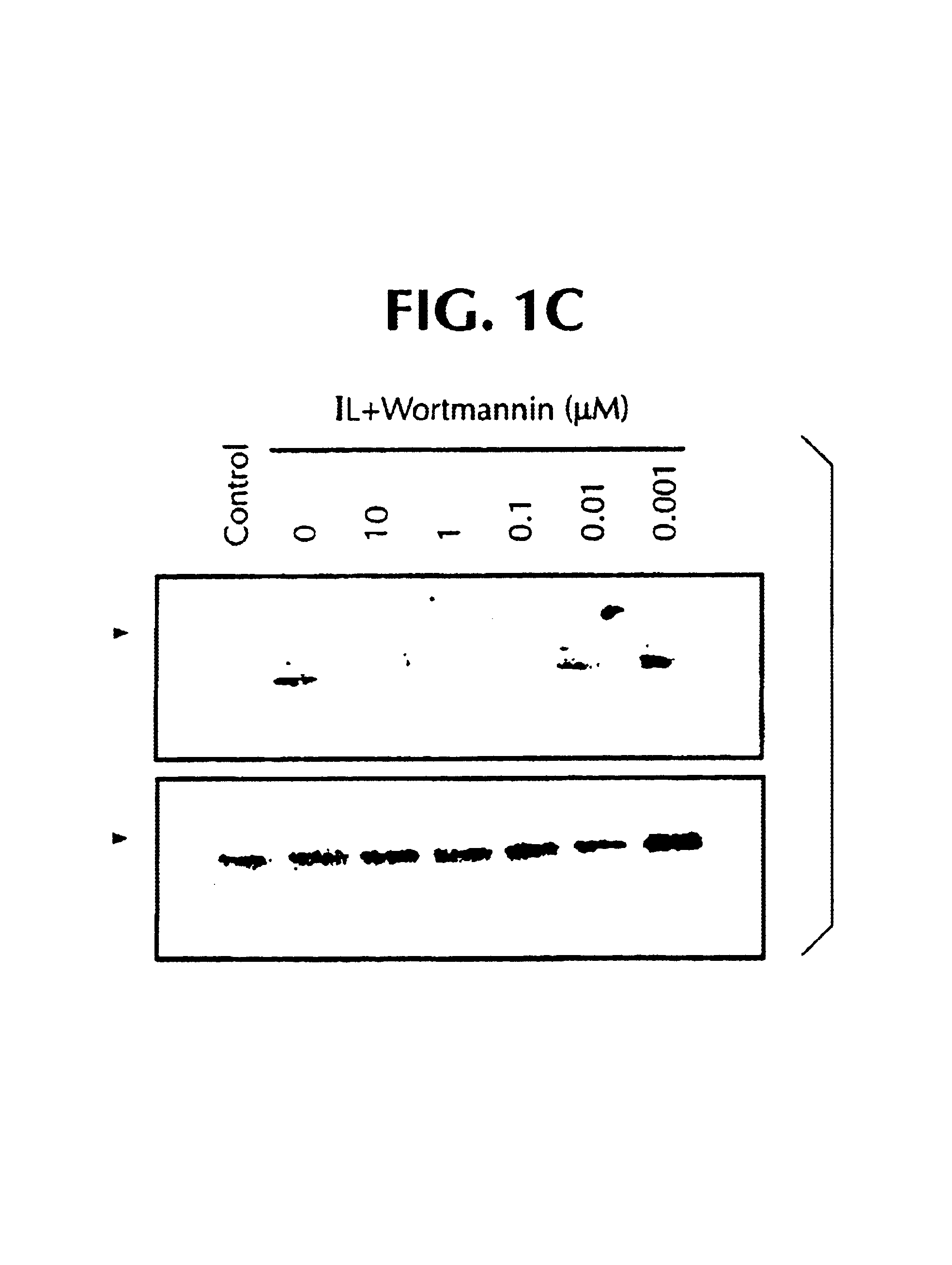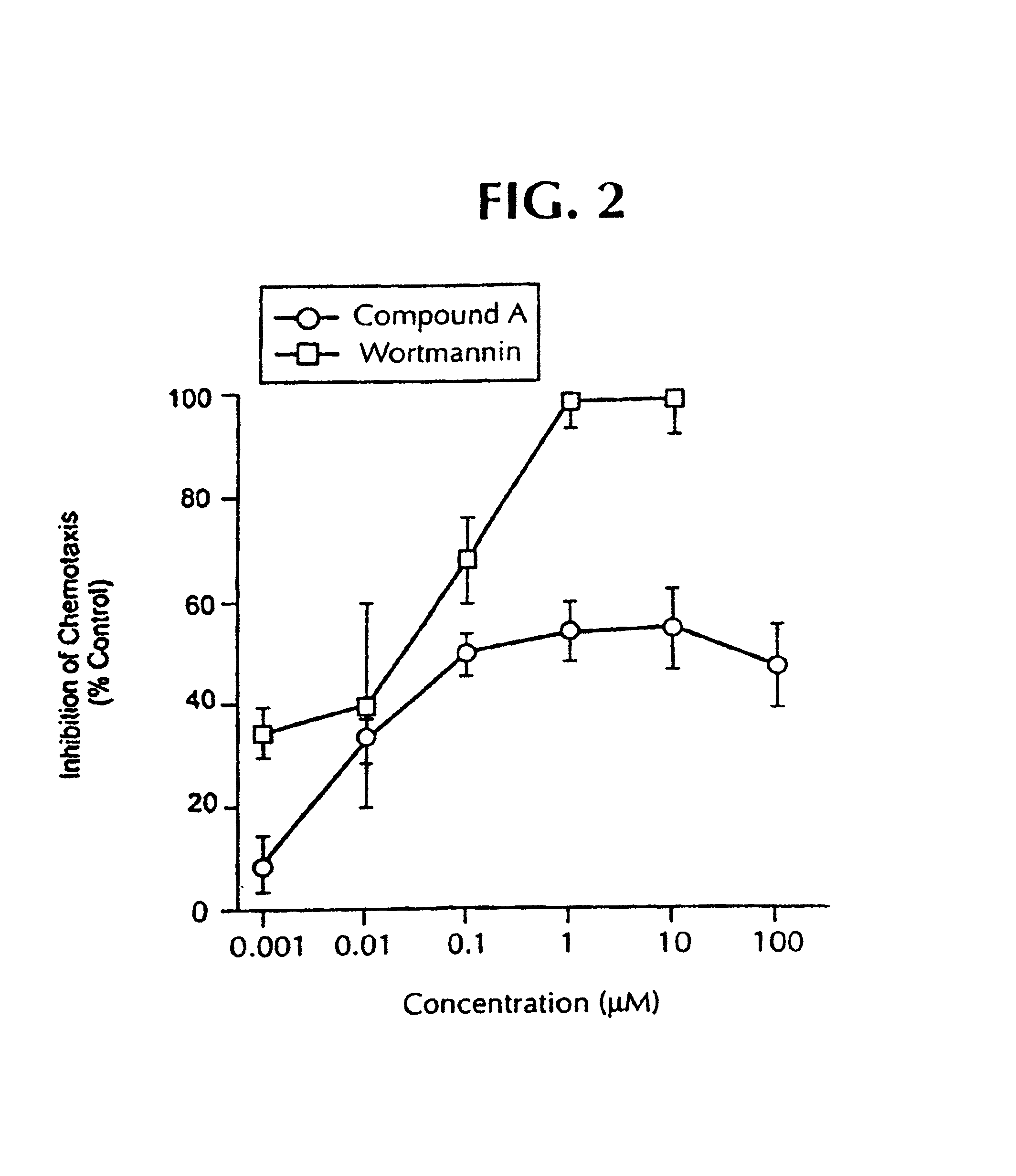Method of treating or inhibiting neutrophil chemotaxis by administering a MEK inhibitor
a neutrophil chemotaxis and mek inhibitor technology, applied in the field of treating or inhibiting neutrophil migration or chemotaxis in a patient, can solve the problem of controversial role of erk, and achieve the effect of inhibiting neutrophil migration/chemotaxis
- Summary
- Abstract
- Description
- Claims
- Application Information
AI Technical Summary
Benefits of technology
Problems solved by technology
Method used
Image
Examples
example 1
IL-8 Activation of ERK is Inhibited by 2-(2-chloro-4-iodo-phenylamino)-N-cyclopropylmethoxy-3,4-difluoro-benzamide (Compound A) and Wortmannin
[0670]To confirm IL-8 activation of ERK, neutrophils were stimulated with 3 nM of IL-8 for various periods of time, ranging from 0 to 30 minutes (FIG. 1A). Consistent with previous observations, IL-8 activation of ERK was evident by 1-minute post-IL-8 stimulation, however was maximal at 5 minutes posttreatment. No visible ERK activation was noticed after 15 minutes of IL-8 treatment. Hence, for all subsequent experiments, to evaluate the inhibitory effects of specific kinase inhibitors, neutrophils were stimulated with IL-8 for 5 minutes after incubation with appropriate inhibitors. These results are consistent with previous observations, where IL-8 stimulation of neutrophils or fibroblast cells transfected with CXCR1 of CXCR2 activated ERK in a time and dose dependent manner (Shyamala V., Khoja H. Interleukin-8 receptors R1 and R2 activate mi...
example 2
2-(2-Chloro-4-iodo-phenylamino)-N-cyclopropylmethoxy-3,4-difluoro-benzamide (Compound A) or Wortmannin Inhibits IL-8-Stimulated Neutrophil Chemotaxis
[0672]To assess the role of ERK in mediating the IL-8 originated neutrophil chemotaxis, we initially tested the efficacy of 2-(2-chloro-4-iodo-phenylamino)-N-cyclopropylmethoxy-3,4-difluoro-benzamide or Wortmannin in an in vitro chemotaxis transwell chamber assay. MEK inhibitor, 2-(2-chloro-4-iodo-phenylamino)-N-cyclopropylmethoxy-3,4-difluoro-benzamide, inhibited in vitro neutrophil chemotaxis with an IC50 of 0.14 μM. As seen in FIG. 2, inhibition of chemotaxis followed a dose response curve, with minimal inhibition at 0.001 μM, increasing to about 60% at concentrations of 0.1 μM. However, there was no additional increase in the chemotaxis inhibition at higher concentrations, 1, 10, or 100 μM. This is in agreement with the fact that 0.1 μM of 2-(2-chloro-4-iodo-phenylamino)-N-cyclopropylmethoxy-3,4-difluoro-benzamide almost completely ...
example 3
Additional Effects of 2-(2-chloro-4-iodo-phenylamino)-N-cyclopropylmethoxy-3,4-difluoro-benzamide (Comppund A) or Wortmannin in Chemotaxis Inhibition
[0674]In order to better establish the presence of two pathways involved in IL-8-induced neutrophil chemotaxis, the two inhibitors, MEK and PI3K, were combined. In one set of experiments, various doses of 2-(2-chloro-4-iodo-phenylamino)-N-cyclopropylmethoxy-3,4-difluoro-benzamide were tested together with one concentration (0.01 μM) of Wortmannin, and in the other set of experiments, various doses of Wortmannin were tested together with one concentration (0.1 μM) of 2-(2-chloro-4-iodo-phenylamino)-N-cyclopropylmethoxy-3,4-difluoro-benzamide (FIG. 3).
[0675]The concentration of 0.01 μM for Wortmannin was chosen based on the Western blot observations; at this concentration Wortmannin had a minimal effect on IL-8-induced ERK activation but inhibited ˜30% of chemotaxis. Upon addition of 2-(2-chloro-4-iodo-phenylamino)-N-cyclopropylmethoxy-3,...
PUM
| Property | Measurement | Unit |
|---|---|---|
| body weight | aaaaa | aaaaa |
| temperature | aaaaa | aaaaa |
| temperature | aaaaa | aaaaa |
Abstract
Description
Claims
Application Information
 Login to View More
Login to View More - R&D
- Intellectual Property
- Life Sciences
- Materials
- Tech Scout
- Unparalleled Data Quality
- Higher Quality Content
- 60% Fewer Hallucinations
Browse by: Latest US Patents, China's latest patents, Technical Efficacy Thesaurus, Application Domain, Technology Topic, Popular Technical Reports.
© 2025 PatSnap. All rights reserved.Legal|Privacy policy|Modern Slavery Act Transparency Statement|Sitemap|About US| Contact US: help@patsnap.com



